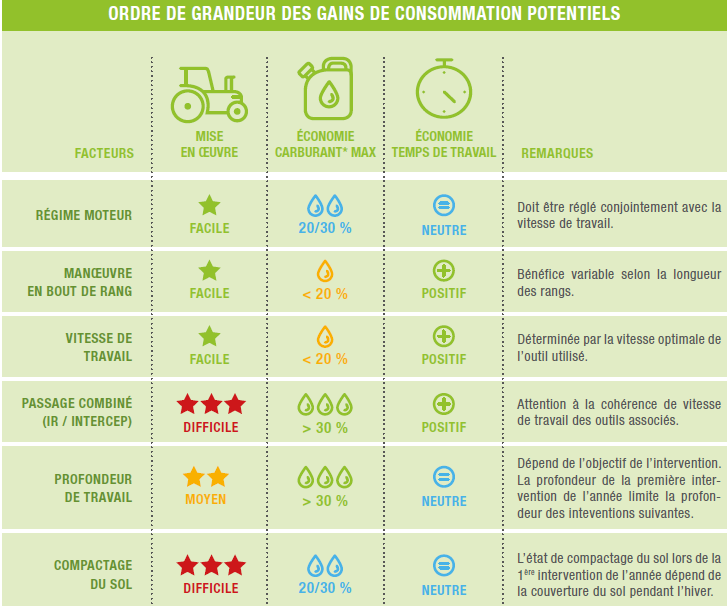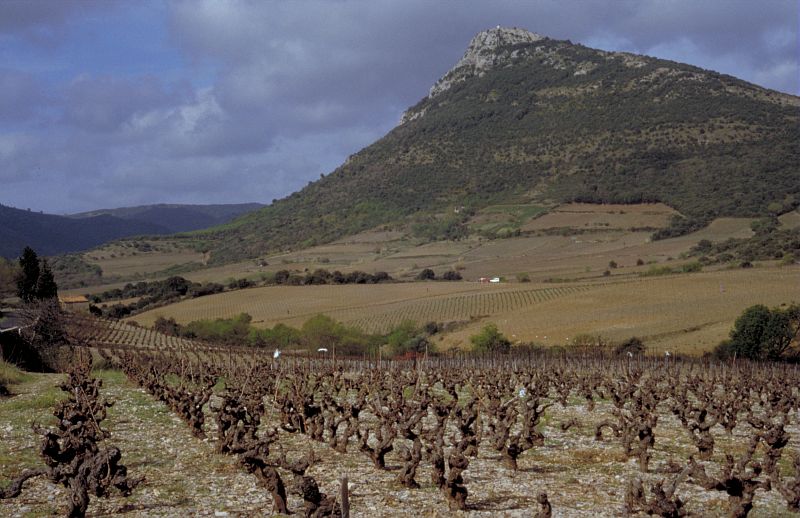Soil management

Soil maintenance is an important part of the technical itinerary of the vine. It participates in the management of weeds and helps to modify its hydrodynamic and physicochemical properties, via an impact on root development, the capacity for water infiltration, erosion and mineralization.
Soil is part of the terroir and therefore part of the definition of a wine. Soil can be characterized by its composition and texture. The texture of a soil can be defined by its share of clays, sand and silt. It defines whether a soil is more or less subject to beating, mass recovery, crumbling, or water retention (useful reserve), and opposes more or less resistance to the advancement of tools. (Gaviglio, 2013)
The soil is also the plant's reservoir for water and minerals. The characteristics of the soil, including its texture, in particular define its useful water reserve. The climate, for its part, determines the availability of water for the vines during the vintage. The soil water balance is the availability of water for the vine. It is the difference between the balance between inputs (rains and possibly irrigations) and water outputs (runoff, drainage, consumption of vines, grass and evaporation from the soil.
The issues around wine-growing soils are:
Land degradation
The degradation caused by unsuitable practices leads to a loss of soil functionality: loss of fertility, crop support capacities, purification capacities, biodiversity, etc.
Table 1: The risks of soil degradation (extract from Gaviglio, 2013)
|
Main risks on European soils (European Commission, 2006) |
At risks situations |
Diagnostic elements |
|
Erosion (hydric) |
Steep slope Light-textured floors Frequent stormy episodes Ground work |
Accumulation of soil at the bottom of the plot Presence of gullies Clearing of vines |
|
Decrease in organic matter (OM) |
Lack of contribution and / or return Erosion |
Soil analyzes Past |
|
Contamination |
Non-control of inputs (particular problem of copper in viticulture) Accidental pollution |
Soil analyzes Traceability of inputs Plant mortality |
|
Settlement |
Tillage and passages in non-wet soil Often congested plots Silty texture Clay texture |
Pedological observations Bulk density measurements |
|
Biodiversity losses |
|
Observations Analyzes |
|
Salinization |
Coastal areas |
Soil analyzes Plant analyzes Symptoms on vines |
|
Flood and landslide |
High hazard areas |
Hazard mapping Past |
|
Waterproofing |
Peri-urban vineyards |
|
The main risks are:
- Erosion and reduced organic matter levels limit the soil's ability to retain water and mineral elements, resulting in a gradual loss of soil fertility.
- Compaction phenomena reduce soil porosity, which restricts the development and efficiency of the root system, and has many impacts on soil life. These phenomena are suspected to be the cause of dieback on certain types of soil in the Mediterranean region. (Gaviglio, 2013)
- Settlement can therefore result in disruption of water and mineral supplies. It can be the consequence of the passage of machinery but also of deep plowing, which should not be neglected. Grassing can be beneficial in limiting compaction. Some principles to limit the impacts of mechanization on soil compaction (Gaviglio, 2013):
- Avoid work on wet ground: anticipate.
- Avoid any systematic action: reason to limit the number of interventions.
- Avoid loosening before harvest.
- As far as possible, alternate the rows used for the passage of the heaviest machines: distribute the load on the soil (eg: for spraying).
- Make a relevant choice of tire fitting and do not neglect the adjustment of the working pressure
- Soil contamination by heavy metals, which can lead to toxicity phenomena, especially in acidic soils
Impact of climate change on the soil and its management
According to the MétéoFrance CNRM / GMGEC scenarios, scenario A2, climate change should result in the Mediterranean regions by a slight decrease in precipitation and a modification of its distribution (more important in autumn / winter and rarer in spring / summer ). This will result in a stronger and longer water deficit. It is therefore important to have good soil management to promote water retention and avoid runoff.
What to do ?
- Avoid runoff from heavy rains
- Improve soil permeability and porosity
- Limit competition for water
What solutions?
- Support the life of earthworms and worms because their subvertical galleries allow the export of organic matter more in depth and improve soil aeration and water infiltration.
Incorporation of organic matter, to limit erosion by limiting runoff and also to limit settlement. The amounts to incorporate depend on the type of soil and the yield objectives. Be careful because an excess of organic matter, in particular nitrogen, can adversely affect the quality of the wine.
Mulch, made of organic products with a high C / N ratio, protects the soil from erosion, limits the development of weeds and constitutes a trophic resource for living soil organisms.
Controlled natural grass, destroyed before the summer water stress in the Mediterranean. Ground cover limiting runoff and not competing for summer water. Depending on the plant species present, the roots can promote permeability.
Grass cover also promotes soil stability and therefore limits erosion. - Winter grassing: Cereals are sown after the harvest and returned in spring. This makes it possible to recover the nitrogen available in the fall and to enrich the soil with organic matter. Beware of the risk of excess nitrogen which could adversely affect the quality of the wine.
The management of the interrupt as an adaptation (Lebon, 2014)
Inter-row management techniques offer multiple possibilities for improving water availability for the vines by modulating the various components of the plot's water balance. Superficial tillage is a traditional technique in the Mediterranean area which aims to limit the flow of evaporation and competition from weeds. Less developed in the Mediterranean region, weeding techniques, expanding in most European vineyards, offer interesting possibilities for limiting the spring vigor of the vines and their water requirements, improving the winter water recharge of the soil, favoring by effect competition, a redistribution of deep rooting and access to deep water reserves (Celette et al., 2008, 2013). The experimental results show that these benefits compensate, in the Mediterranean region and on deep soils, most of the water losses induced by spring transpiration of the herbaceous cover. Current work on modeling the coupled dynamics of water and nitrogen offers the possibility of designing systems adapted to different ranges of environment (Celette et al., 2010; Ripoche et al., 2010).
How can soil management play a role in CC mitigation? Carbon storage
The vine being a perennial crop, the storage induced by the vegetation in place and the root system is interesting, but the organic returns to the soil are relatively low. Cultural practices favorable to carbon storage are those which increase the input of organic matter or which limit the output. The greater the production of the crop, the greater the storage in the aerial parts and the roots. We can say that there is carbon destocking by tillage, because it accelerates the mineralization of organic matter. The abandonment of plowing and the presence of grass in the vines, on the other hand, make it possible to combine the increase in inputs by capturing carbon from the plant cover and restitution to the soil (unharvested mowing).
Controlling soil management costs: sustainability of the operation
Managing the soil with fewer available herbicides often leads to more labor and costs; we must therefore ensure that it remains manageable for operators, both from the point of view of the organization of work and from a purely economic standpoint. A study by Sudvinbio and IFV has shown levers that can be easily mobilized to save GNR:


Decision support tools exist to assess the cost of different choices in floor maintenance.
- Viticoût®: creation of IFV Sud-Ouest, this software accessible to all on the Internet makes it possible to estimate and compare costs for the entire production route, in order to situate soil maintenance in a context wider mechanization.
- The Philagro site: (http://jentrensmavigne.fr) focused solely on soil maintenance, allows, from simple choices (region, available equipment), to compare and personalize different maintenance routes for the ground.
References :
Celette F., Gaudin R., Gary C., 2008. Spatial and temporal changes to the water regime of a Mediterranean vineyard due to the adoption of cover cropping. European Journal of Agronomy 29, 153-162.
Celette F., Ripoche A., Gary C., 2010. WaLIS-A simple model to simulate water partitioning in a crop association: The example of an intercropped vineyard. Agricultural Water Management 97, 1749-1759.
Celette F., Gary C., 2013. Dynamics of water and nitrogen stress along the grapevine cycle as affected by cover cropping. European Journal of Agronomy 45, 142-152.
Institut français de la vigne et du vin, Gaviglio, C., 2013. Gestion des sols viticoles. Ed. France agricole, Paris.
Lebon, Eric & Garcia de Cortazar-Atauri, Iñaki, 2014. Dans un contexte de changement climatique, quels sont les impacts de la sécheresse sur la vigne et sur le devenir des vignobles ? L'exemple du Languedoc. Innovations Agronomiques, INRA, 38, pp.1-12. hal-02630183 https://hal.inrae.fr/hal-02630183/document
Ripoche A., Celette F., Cinna J.P., Gary C., 2010. Design of intercrop management plans to fulfil production and environmental objectives in vineyards. European Journal of Agronomy 32, 30-39
Other references
Leonard, J., & Andrieux, P. (1998). Infiltration characteristics of soils in Mediterranean vineyards in Southern France. Catena, 32(3–4), 209–223. https://doi.org/10.1016/S0341-8162(98)00049-6
Raclot, D., Le Bissonnais, Y., Louchart, X., Andrieux, P., Moussa, R., & Voltz, M. (2009). Soil tillage and scale effects on erosion from fields to catchment in a Mediterranean vineyard area. Agriculture, Ecosystems and Environment, 134(3–4), 201–210. https://doi.org/10.1016/j.agee.2009.06.019
Other references on porosity and precipitation impact on soil:
Holland, J. M. (2004). The environmental consequences of adopting conservation tillage in Europe: Reviewing the evidence. Agriculture, Ecosystems and Environment, 103(1), 1–25. https://doi.org/10.1016/j.agee.2003.12.018
Hill, R. L., & Meza-Montalvo, M. (1990). Long-Term Wheel Traffic Effects on Soil Physical Properties under Different Tillage Systems. Soil Science Society of America Journal, 54(3), 865–870. https://doi.org/10.2136/sssaj1990.03615995005400030042x
Meek, B. D., Rechel, E. R., Carter, L. M., Detar, W. R., & Urie, A. L. (1992). Infiltration rate of a sandy loam soil: effects of traffic, tillage, and plant roots. Soil Science Society of America Journal, 56(3), 908–913. https://doi.org/10.2136/sssaj1992.03615995005600030038x
Alvarez, R., & Steinbach, H. S. (2009). A review of the effects of tillage systems on some soil physical properties, water content, nitrate availability and crops yield in the Argentine Pampas. Soil and Tillage Research, 104(1), 1–15. https://doi.org/10.1016/j.still.2009.02.005
Young, I. M. (1992). Hardsetting soils in the UK. Soil and Tillage Research, 25(2–3), 187–193. https://doi.org/10.1016/0167-1987(92)90110-W
Relations
- Network
- List
- Geolocation
- More
Un article dans TheConversation montre que face au changement climatique les vins d'appellation doivent s'appuyer sur une cogestion adaptative de leur terroir
- More
GeSoVit - Innovazioni per la gestione sostenibile del vigneto e per la definizione dei criteri di certificazione di sostenibilità ambientale per l'azienda vitivinicola
Adozione di nuove pratiche per una generale riduzione dell’impatto ambientale e protocolli propedeutici e funzionali per la certificazione di sostenibilità ambientale dell’azienda vitivinicola
- More
Institut Français de la Vigne et du Vin - IFV
L'Institut Français de la Vigne et du Vin, centre technique, régi par le code de la recherche, a pour mission d’intérêt général de conduire des études de portée générale pour l’ensemble de la filière viti-vinicole.
- More
Syndicat AOP Languedoc - Appellation d'Origine Protégée Languedoc
Le Syndicat de l’AOP Languedoc a été reconnu en 2008 par l’INAO organisation de défense et de gestion (ODG) de l’appellation.
- More
VIRECLI - Viticoltura reseliente ai cambiamenti climatici
Il gruppo operativo per l’innovazione VIRECLI (cofinanziato dal PSR di Regione Lombardia) esplora le potenzialità dell’agricoltura di precisione come strumento per rispondere ad alcune problematiche emergenti del settore vitivinicolo




